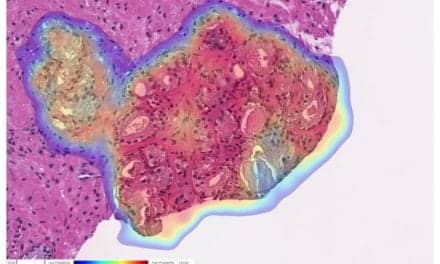In a recent press release from Hologic Inc, Marlborough, Mass, the company expressed deep concern that draft cervical cancer screening recommendations released in September by the United States Preventive Services Task Force (USPSTF) did not include a grade for cotesting with the Pap test and human papilloma virus screening. According to the company, the draft recommendations do not consider the wealth of data supporting the value of cotesting, and will put the lives of American women at risk if implemented.
“These draft recommendations represent a significant change from current practice and are a clear step back in protecting women from cervical cancer,” said Steve MacMillan, Hologic’s chairman, president, and CEO. “We are concerned that lives will be lost if women are denied access to cotesting if these draft recommendations are implemented.”
Multiple large studies conducted in the United States have demonstrated that screening with cotesting identifies more cervical precancer and cancer than either test used alone.1–6 The largest retrospective study of cervical cancer screening strategies found that nearly one out of five cases of cervical cancer was missed with HPV-alone screening.2
According to Hologic, evidence cited in the USPSTF draft recommendations rely heavily on studies conducted outside the United States—including some that employed cytology methods no longer widely used in the United States—and HPV tests that are not approved by FDA for primary use. Further, the USPSTF cited findings from a modeling study that may have unfairly skewed results in favor of HPV-alone testing.
“We find it disturbing that the USPSTF did not place more weight on the results of important studies in American women, but instead included European studies employing outdated technologies that have limited, if any, relevance to the US healthcare landscape,” said Edward Evantash, MD, Hologic’s medical director and vice president for medical affairs. “Further, the limited information available on the design of the modeling study makes it difficult to interpret the results, but it seems to defy logic that these two valuable tests together did not perform as well as HPV-alone testing.”
The draft recommendations grant a grade A to the Pap test at 3-year intervals for women aged 21–65.
According to the press release, Hologic believes strongly in the power of the Pap test and the valuable contribution it has made to women’s health. Before introduction of the Pap test, the company noted, cervical cancer was the leading cause of cancer-related deaths for women in the US, but now ranks 14th in frequency.7 Studies demonstrate, however, that administering a Pap and HPV test at the same time is the ideal strategy for detecting cervical cancer and precancer in women aged 30 and older.3–5 Large, US-based studies also show that a cotesting interval of 3 years is optimal.8,9
“We urge USPSTF to reinstate an A grade for cotesting and to add language within revised recommendations to allow screening interval flexibility for healthcare providers and their patients, as was recently recommended by the Health Resources and Services Administration (HRSA) in their Women’s Preventive Health Services Guidelines,” said Evantash.10
For more information, visit Hologic.
REFERENCES
- Zhou H, Mody RR, Luna E, et al. Clinical performance of the Food and Drug Administration–approved high-risk HPV test for the detection of high-grade cervicovaginal lesions. Cancer Cytopathol. 2016;124(5):317–323; doi: 10.1002/cncy.21687.
- Blatt AJ, Kennedy R, Luff RD, Austin RM, Rabin DS. (2015), Comparison of cervical cancer screening results among 256,648 women in multiple clinical practices. Cancer Cytopathol. 2015;123(5):282–288; doi: 10.1002/cncy.21544.
- Katki HA, Kinney WK, Fetterman B, et al. Cervical cancer risk for women undergoing concurrent testing for human papillomavirus and cervical cytology: a population-based study in routine clinical practice. Lancet Oncol. 2011;12(7):663–672; doi: 1016/s1470-2045(11)70145-0.
- Gage JC, Hunt WC, Schiffman M, et al. Similar risk patterns after cervical screening in two large US populations: implications for clinical guidelines. 2016;128(6):1248–1257; doi: 1097/aog.0000000000001721.
- Gage JC, Schiffman M, Katki HA, et al. Reassurance against future risk of precancer and cancer conferred by a negative human papillomavirus test. J Natl Cancer Inst. 2014;106(8):dju153; doi: 10.1093/jnci/dju153.
- Katki HA, Schiffman M, Castle PE, et al. Five-year risks of CIN 3+ and cervical cancer among women who test Pap-negative but are HPV-positive. J Low Genit Tract Dis. 2013;17(5 Suppl 1):S56–S63; doi: 10.1097/lgt.0b013e318285437b.
- Cervical Cancer [online]. Bethesda, Md: National Institutes of Health, 2013. Available at: report.nih.gov/nihfactsheets/viewfactsheet.aspx?csid=76. Accessed September 13, 2017.
- Kinney W, Wright TC, Dinkelspiel HE, DeFrancesco M, Thomas Cox J, Huh W. Increased cervical cancer risk associated with screening at longer intervals. Obstet Gynecol. 2015;125(2):311–315; doi: 10.1097/aog.0000000000000632.
- Kulasingam SL, Havrilesky LJ, Ghebre R, Myers ER. Screening for cervical cancer: A modeling study for the US Preventive Services Task Force. J Low Genit Tract Dis. 2013;17(2):193–202; doi: 10.1097/lgt.0b013e3182616241.
- Women’s Preventive Services Guidelines [online]. Rockville, Md: Health Resources and Services Administration, 2016. Available at: hrsa.gov/womensguidelines. Accessed September 13, 2017.





